Flat Earth

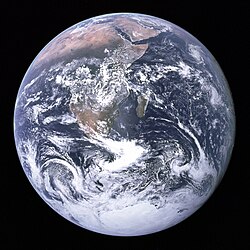
The Flat Earth model is a view that the Earth's shape is a flat plane or disk. Various cultures have had conceptions of a flat Earth, such as Babylon, Ancient Egypt, pre-Classical Greece, pre-Classical India and pre-17th century China.
Beginning from ancient Greek astronomy, the paradigm of a round (or more accurately, spherical) earth gradually spread around the world supplanting the older cosmological belief in a flat earth.[1][2][3][4]
The false belief that medieval Christianity believed in a flat earth has been referred to as The Myth of the Flat Earth.[5] In 1945, it was listed by the Historical Association (of Britain) as the second of 20 in a pamphlet on common errors in history.[6] The myth that people of the Middle Ages believed that the Earth was flat only entered the popular imagination in the 19th century, thanks largely to the publication of Washington Irving's fantasy The Life and Voyages of Christopher Columbus in 1828.[5]
Although the hypothesis of the flat Earth has long been generally dismissed, there are still occasional modern advocates of the hypothesis.
Historical development
Ancient Near East
Belief in a flat Earth is found in mankind's oldest writings, such as the Epic of Gilgamesh. In early Egyptian[7], and Mesopotamian thought the world was portrayed as a flat disk floating in the ocean, and this forms the premise for early Greek maps such as those of Anaximander and Hecataeus of Miletus.[citation needed]
The Hebrew Bible carried forward the ancient Middle Eastern cosmology, revealed partly in the Enuma Elish, which described a flat earth with a solid roof, surrounded by water above and below.[8][9]
Isaiah 40:22
There is an occasional opinion offered that an early statement of a spherical earth occurs in the 8th century BC, in Isaiah 40:22 "It is he that sitteth upon the circle of the earth...".[10] The Hebrew word translated as "circle" is generally recognized as referring to a plane figure (perhaps the horizon), or possibly the vault of the heavens rather than the shape of the earth.[11] However, this Hebrew word, chûgh, may also be rendered as "sphere"[12] As a result, certain Bible translations read “the globe of the earth” (Douay Version) and “the round earth” (Moffatt). A secondary issue is that this text is part of Deutero-Isaiah, often ascribed to the 6th century BC (and thus roughly contemporaneous with Pythagoras).[13]
The Western world abandons the concept
Beginning in ancient Greece, the concept of a flat earth was largely rejected in educated circles and appears only rarely. Some writers in the 19th century and 20th centuries promoted the notion that medieval Christianity or Europe in general during the Dark Ages had embraced the concept again (see Myth of the Flat Earth) However, contemporary scholarship rejects this notion as historically unfounded.
Classical Greco-Roman world
- "Thales believed the Earth to be a flat disk floating on an infinite ocean ... " [16]
Parmenides conceived of a spherical Earth.[14]
Pythagoras in the 6th century BC, apparently on aesthetic grounds, held that all the celestial bodies were spherical. However,
- It was reported that Pythagoras reasoned from the perpetual round shape of lunar eclipses that the Earth could neither be flat nor cylindrical, but only spherical. [17]
Many pre-Socratic philosophers considered the world to be flat, at least according to Aristotle.[15] According to Aristotle, pre-Socratic philosophers, including Leucippus (c. 440 BC) and Democritus (c. 460–370 BC) believed in a flat earth.[16] Anaximander believed the Earth to be a short cylinder with a flat, circular top which remained stable because it is the same distance from all things.[17] It has been suggested that seafarers probably provided the first observational evidence that the Earth was not flat.[18]
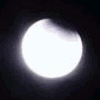
Around 330 BC, Aristotle provided observational evidence for the spherical Earth,[19] noting that travelers going south see southern constellations rise higher above the horizon. He argued that this was only possible if their horizon was at an angle to northerners' horizon and that the Earth's surface therefore could not be flat.[20] He also noted that the border of the shadow of Earth on the Moon during the partial phase of a lunar eclipse is always circular, no matter how high the Moon is over the horizon. Only a sphere casts a circular shadow in every direction, whereas a circular disk casts an elliptical shadow in all directions apart from directly above and directly below.[21] Writing around 10 BC, the Greek geographer Strabo cited various phenomena observed at sea as suggesting that the Earth was spherical.

He observed that elevated lights or areas of land were visible to sailors at greater distances than those which were less elevated, and stated that the curvature of the sea was obviously responsible for this.[22] He also remarked that observers can see further when their eyes are elevated, and cited a line from the Odyssey[23] as indicating that the poet Homer was already aware of this as early as the 7th or 8th century BC.
The Earth's circumference was first determined around 240 BC by Eratosthenes. Eratosthenes knew that in Syene, in Egypt, the Sun was directly overhead at the summer solstice, while he estimated that the angle formed by a shadow cast by the Sun at Alexandria was 1/50th of a circle. He estimated the distance from Syene to Alexandria as 5,000 stades, and estimated the Earth's circumference was 250,000 stades and a degree was 700 stades (implying a circumference of 252,000 stades).[24] Eratosthenes used rough estimates and round numbers, but depending on the length of the stadion, his result is within a margin of between 2% and 20% of the actual meridional circumference, 40,008 kilometres (24,860 mi). Note that Eratosthenes could only measure the circumference of the Earth by assuming that the distance to the Sun is so great that the rays of sunlight are essentially parallel.
Lucretius (1st. c. BC) opposed the concept of a spherical Earth, because he considered the idea of antipodes absurd. But by the 1st century AD, Pliny the Elder was in a position to claim that everyone agrees on the spherical shape of Earth,[25] although there continued to be disputes regarding the nature of the antipodes, and how it is possible to keep the ocean in a curved shape. Pliny also considers the possibility of an imperfect sphere, "shaped like a pinecone".[25]
In the second century the Alexandrian astronomer Ptolemy advanced many arguments for the sphericity of the Earth. Among them was the observation that when sailing towards mountains, they seem to rise from the sea, indicating that they were hidden by the curved surface of the sea. He also gives separate arguments that the Earth is curved north-south and that it is curved east-west.[26] Ptolemy derived his maps from a curved globe and developed the system of latitude, longitude, and climes. His writings remained the basis of European astronomy throughout the Middle Ages, although Late Antiquity and the Early Middle Ages (ca. 3rd to 7th centuries) saw occasional arguments in favor of a flat Earth.
The Jerusalem Talmud says that Alexander of Macedon (Alexander the Great) was lifted by birds to the point that he saw the curvature of the Earth. This story is mentioned as well by the Tosafos commentary on the Babylonian Talmud. This is used to explain why a statue of a person holding a sphere in his hand is assumed to be an idol. The sphere being held in its hand symbolizing the idol's purported dominion over the world whose shape is a sphere.
In late antiquity such widely read encyclopedists as Macrobius (4th c.) and Martianus Capella (5th c.) discussed the circumference of the sphere of the Earth, its central position in the universe, the difference of the seasons in northern and southern hemispheres, and many other geographical details.[27] In his commentary on Cicero's Dream of Scipio, Macrobius described the Earth as a globe of insignificant size in comparison to the remainder of the cosmos.[27]
Early Christian Church
From Late Antiquity, and from the beginnings of Christian theology, knowledge of the sphericity of the Earth had become widespread.[28] There was some debate concerning the possibility of the inhabitants of the antipodes: people imagined as separated by an impassable torrid clime were difficult to reconcile with the Christian view of a unified human race descended from one couple and redeemed by a single Christ.
Saint Augustine (354–430) argued against assuming people inhabited the antipodes:
But as to the fable that there are Antipodes, that is to say, men on the opposite side of the earth, where the sun rises when it sets to us, men who walk with their feet opposite ours, that is on no ground credible. And, indeed, it is not affirmed that this has been learned by historical knowledge, but by scientific conjecture, on the ground that the earth is suspended within the concavity of the sky, and that it has as much room on the one side of it as on the other: hence they say that the part which is beneath must also be inhabited. But they do not remark that, although it be supposed or scientifically demonstrated that the world is of a round and spherical form, yet it does not follow that the other side of the earth is bare of water; nor even, though it be bare, does it immediately follow that it is peopled.[29]
Since these people would have to be descended from Adam, they would have had to travel to the other side of the Earth at some point; Augustine continues:
It is too absurd to say, that some men might have taken ship and traversed the whole wide ocean, and crossed from this side of the world to the other, and that thus even the inhabitants of that distant region are descended from that one first man.
Scholars of Augustine's work have traditionally understood him to have shared the common view of his educated contemporaries that the earth is spherical, in line with the quotation above, and with Augustine's famous endorsement of science in De Genesi ad litteram.[30] That tradition has, however, recently been challenged by Leo Ferrari, who concluded that many of Augustine's passing references to the physical universe imply a belief in an essentially flat earth "at the bottom of the universe".[31][32] Some authors and artists less prominent in the Church's history directly opposed the round Earth. After his conversion to Christianity, Lactantius (245–325) became a trenchant critic of all pagan philosophy. In Book III of The Divine Institutes[33] he ridicules the notion that there could be inhabitants of the antipodes "whose footsteps are higher than their heads". After presenting some arguments which he claims advocates for a spherical heaven and earth had advanced to support their views, he writes:
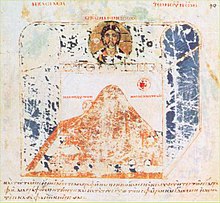
But if you inquire from those who defend these marvellous fictions, why all things do not fall into that lower part of the heaven, they reply that such is the nature of things, that heavy bodies are borne to the middle, and that they are all joined together towards the middle, as we see spokes in a wheel; but that the bodies which are light, as mist, smoke, and fire, are borne away from the middle, so as to seek the heaven. I am at a loss what to say respecting those who, when they have once erred, consistently persevere in their folly, and defend one vain thing by another;
Diodorus of Tarsus (d. 394) may have argued for a flat Earth based on scriptures; however, Diodorus' opinion on the matter is known to us only by a criticism of it by Photius.[34] Severian, Bishop of Gabala (d. 408), wrote that the earth is flat and the sun does not pass under it in the night, but "travels through the northern parts as if hidden by a wall".[35] The Egyptian monk Cosmas Indicopleustes (547) in his Topographia Christiana, where the Covenant Ark was meant to represent the whole universe, argued on theological grounds that the Earth was flat, a parallelogram enclosed by four oceans.
In his Homilies Concerning the Statutes[36] St.John Chrysostom (344–408) explicitly espoused the idea, based on his reading of Scripture, that the Earth floated on the waters gathered below the firmament, and St. Athanasius (c.293–373) expressed similar views in Against the Heathen.[37][original research?]
A very recent essay by Leone Montagnini, discussing the question of the shape of the Earth from the origins to the late Antiquity, has shown that the Fathers of the Church shared different approaches, in order to their overall philosophical and theological visions. Those of them who were more close to Platonic visions, like Origen, shared peacefully the geosphericism. A second tradition, including Basil, Ambrose and Augustine, but also Philoponus, accepted the idea of the round Earth and the radial gravity, but in a critical way. In particular they pointed out a number of doubts about the physical reasons of the radial gravity, and hesitated in accepting the physical reasons proposed by Aristotles or the Stoicism. However, a "flattist" approach was more or less shared by all the Fathers coming from the Syriac area, who were more inclined to follow the letter of the Old Testament[citation needed]. Diodorus, Severian, and Cosmas Indicopleustes, but also Chrysostom, belonged just to this latter tradition.[38]
At least one early Christian writer, Basil of Caesarea (329–379), believed the matter to be theologically irrelevant.[39]
Early Middle Ages

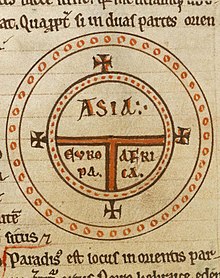

With the end of Roman civilization, Western Europe entered the Middle Ages with great difficulties that affected the continent's intellectual production. Most scientific treatises of classical antiquity (in Greek) were unavailable, leaving only simplified summaries and compilations. Still, the dominant textbooks of the Early Middle Ages supported the sphericity of the Earth. For example: many early medieval manuscripts of Macrobius include maps of the Earth, including the antipodes, zonal maps showing the Ptolemaic climates derived from the concept of a spherical Earth and a diagram showing the Earth (labeled as globus terrae, the sphere of the Earth) at the center of the hierarchically ordered planetary spheres.[40] Further examples of such medieval diagrams can be found in medieval manuscripts of the Dream of Scipio. In the Carolingian era, scholars discussed Macrobius's view of the antipodes. One of them, the Irish monk Dungal, asserted that the tropical gap between our habitable region and the other habitable region to the south was smaller than Macrobius had believed.[41]
Europe's view of the shape of the Earth in Late Antiquity and the Early Middle Ages may be best expressed by the writings of early Christian scholars:
- Boethius (c. 480 – 524), who also wrote a theological treatise On the Trinity, repeated the Macrobian model of the Earth as an insignificant point in the center of a spherical cosmos in his influential, and widely translated, Consolation of Philosophy.[42]
- Bishop Isidore of Seville (560 – 636) taught in his widely read encyclopedia, the Etymologies, that the Earth was round. His meaning was ambiguous and some writers think he referred to a disc-shaped Earth; his other writings make it clear, however, that he considered the Earth to be globular.[43] He also admitted the possibility of people dwelling at the antipodes, considering them as legendary[44] and noting that there was no evidence for their existence.[45] Isidore's disc-shaped analogy continued to be used through the Middle Ages by authors clearly favouring a spherical Earth, e.g. the 9th century bishop Rabanus Maurus who compared the habitable part of the northern hemisphere (Aristotle's northern temperate clime) with a wheel, imagined as a slice of the whole sphere.
- The monk Bede (c.672 – 735) wrote in his influential treatise on computus, The Reckoning of Time, that the Earth was round, explaining the unequal length of daylight from "the roundness of the Earth, for not without reason is it called 'the orb of the world' on the pages of Holy Scripture and of ordinary literature. It is, in fact, set like a sphere in the middle of the whole universe." (De temporum ratione, 32). The large number of surviving manuscripts of The Reckoning of Time, copied to meet the Carolingian requirement that all priests should study the computus, indicates that many, if not most, priests were exposed to the idea of the sphericity of the Earth.[46] Ælfric of Eynsham paraphrased Bede into Old English, saying "Now the Earth's roundness and the Sun's orbit constitute the obstacle to the day's being equally long in every land."[47]
- Bishop Vergilius of Salzburg (c.700 – 784) is sometimes cited as having been persecuted for teaching "a perverse and sinful doctrine ... against God and his own soul" regarding the sphericity of the earth. Pope Zachary decided that "if it shall be clearly established that he professes belief in another world and other people existing beneath the earth, or in another sun and moon there, thou art to hold a council, and deprive him of his sacerdotal rank, and expel him from the church."[48] The issue involved was not the sphericity of the Earth itself, but whether people living in the antipodes were not descended from Adam and hence were not in need of redemption. Vergilius succeeded in freeing himself from that charge; he later became a bishop and was canonised in the thirteenth century.[49]
A non-literary but graphic indication that people in the Middle Ages believed that the Earth was a sphere, is the use of the orb (globus cruciger) in the regalia of many kingdoms and of the Holy Roman Empire. It is attested from the time of the Christian late-Roman emperor Theodosius II (423) throughout the Middle Ages; the Reichsapfel was used in 1191 at the coronation of emperor Henry VI.
A recent study of medieval concepts of the sphericity of the Earth noted that "since the eighth century, no cosmographer worthy of note has called into question the sphericity of the Earth."[50] However, the work of these intellectuals may not have had significant influence on public opinion, and it is difficult to tell what the wider population may have thought of the shape of the Earth, if they considered the question at all.
High and Late Middle Ages
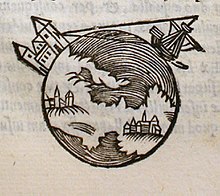
Some historians consider that the early advocates who projected flat Earth upon Christians of the Middle Ages were highly influential (19th century view typified by diplomat and author Andrew Dickson White); other historians strongly criticized White's work of projection as anti-historical (19th century view typified by physician and author James Joseph Walsh); current historians have determined White's and other writings projecting flat Earth belief upon Christians as inaccurate, cited centuries of theological writings, and suggested the motivations for the promotion of such inaccuracies (late 20th century view typified by Religious Studies Scholar Jeffrey Burton Russell).[5]
By the 11th century Europe had learned of Islamic astronomy. The Renaissance of the 12th century from about 1070 started an intellectual revitalization of Europe with strong philosophical and scientific roots, and increased interest in natural philosophy.

Hermannus Contractus (1013–1054) was among the earliest Christian scholars to estimate the circumference of Earth with Eratosthenes' method. Thomas Aquinas (1225–1274), the most important and widely taught theologian of the Middle Ages, believed in a spherical Earth; and he even took for granted his readers also knew the Earth is round.[nb 1] Lectures in the medieval universities commonly advanced evidence in favor of the idea that the Earth was a sphere.[51] Also, "On the Sphere of the World", the most influential astronomy textbook of the 13th century and required reading by students in all Western European universities, described the world as a sphere. Thomas Aquinas, in his Summa Theologica, wrote, "The physicist proves the earth to be round by one means, the astronomer by another: for the latter proves this by means of mathematics, e.g. by the shapes of eclipses, or something of the sort; while the former proves it by means of physics, e.g. by the movement of heavy bodies towards the center, and so forth."[52]
The shape of the Earth was not only discussed in scholarly works written in Latin; it was also treated in works written in vernacular languages or dialects and intended for wider audiences. The Norwegian book Konungs Skuggsjá, from around 1250, states clearly that the Earth is round - and that it is night on the other side of the Earth when it is daytime in Norway. The author also discusses the existence of antipodes - and he notes that they (if they exist) will see the Sun in the north of the middle of the day, and that they will have opposite seasons of the people living in the Northern Hemisphere.
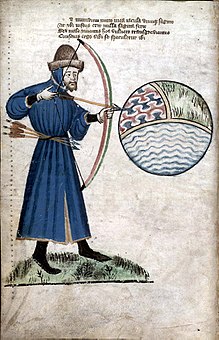
Dante's Divine Comedy, written in Italian in the early 14th century, portrays Earth as a sphere, discussing implications such as the different stars visible in the southern hemisphere, the altered position of the sun, and the various timezones of the Earth. Also, the Elucidarium of Honorius Augustodunensis (c. 1120), an important manual for the instruction of lesser clergy which was translated into Middle English, Old French, Middle High German, Old Russian, Middle Dutch, Old Norse, Icelandic, Spanish, and several Italian dialects, explicitly refers to a spherical Earth. Likewise, the fact that Bertold von Regensburg (mid-13th century) used the spherical Earth as a sermonic illustration shows that he could assume this knowledge among his congregation. The sermon was held in the vernacular German, and thus was not intended for a learned audience.
Reinhard Krüger, a professor for Romance literature at the University of Stuttgart (Germany), has compiled a list of more than 100 medieval Latin and vernacular writers from the late antiquity to the 15th century—79 known by name—whom he identified as knowing that the earth was spherical.[53]
- Kings and politicians
Brunetto Latini, Visigoth king Sisebut, King Alfred of the Anglo-Saxons, Alfonso X of Castile
- Church fathers, popes, bishops, priests, members of religious orders
Basil of Caesarea, Ambrose of Milan, Aurelius Augustinus, Paulus Orosius, Jordanes, Cassiodorus, Isidore of Seville, Beda Venerabilis, Theodulf of Orléans, Vergilius of Salzburg, Irish monk Dicuil, Rabanus Maurus, Remigius of Auxerre, Johannes Scotus Eriugena, Leo of Naples Template:De icon, Gerbert d’Aurillac (Pope Sylvester II), Notker the German of Sankt-Gallen, Hermann the lame, Hildegard von Bingen, Petrus Abaelardus, Honorius Augustodunensis, Gautier de Metz, Adam of Bremen, Albertus Magnus, Thomas Aquinas, Berthold of Regensburg, Meister Eckhart, Enea Silvio Piccolomini (Pope Pius II)
- Theologians, philosophers and encyclopedists
Ampelius, Chalcidius, Macrobius, Martianus Capella, Boethius, Guillaume de Conches, Philippe de Thaon Template:Fr icon, Abu-Idrisi, Bernardus Silvestris, Petrus Comestor, Thierry de Chartres, Gautier de Châtillon, Alexander Neckam, Alain de Lille, Averroes, Moshe ben Maimon, Lambert de Saint-Omer Template:De icon, Gervasius of Tilbury, Robert Grosseteste, Johannes de Sacrobosco, Thomas de Cantimpré, Peire de Corbian, Vincent de Beauvais, Robertus Anglicus, Juan Gil de Zámora Template:Es icon, Perot de Garbelei Template:De icon (divisiones mundi), Roger Bacon, Ristoro d'Arezzo, Cecco d'Ascoli, Fazio degli Uberti Template:It icon, Levi ben Gershon, Konrad of Megenberg, Nicole Oresme, Petrus Aliacensis, Alfonso de la Torre Template:De icon, Toscanelli
- Poets, travellers, printers, seafarers, merchants
Snorri Sturluson, Marco Polo, Dante Alighieri, Brochard the German Template:De icon, Jean de Meung, Jean de Mandeville, Christine de Pizan, Geoffrey Chaucer, William Caxton, Martin Behaim, Christopher Columbus |}
Portuguese exploration of Africa and Asia, Columbus voyage to the Americas (1492) and finally Ferdinand Magellan's circumnavigation of the earth (1519–21) provided the final, practical proofs for the global shape of the earth.
Early modern Europe: Columbus
The common misconception that people before the age of exploration believed that Earth was flat entered the popular imagination after Washington Irving's publication of The Life and Voyages of Christopher Columbus in 1828. This belief is even repeated in some widely read textbooks. Previous editions of Thomas Bailey's The American Pageant stated that "The superstitious sailors [of Columbus' crew] ... grew increasingly mutinous...because they were fearful of sailing over the edge of the world"; however, no such historical account is known.[54] Actually, sailors were probably among the first to know of the curvature of Earth from everyday observations, for example seeing how mountains vanish below the horizon on sailing far from shore.
Irving builds his story of the 1486 Salamanca meeting around the issue of the sphericity of the Earth. He presents some of the arguments against the sphericity (based on the impossibility that there be unredeemed or unredeemable humans on the opposite side);[55] however, he also admits that other learned scholars of the day accepted the sphericity of the Earth.[56]
In reality, the issue in the 1490s was not the shape but the size of the Earth, as well as the position of the east coast of Asia. Historical estimates from Ptolemy onwards placed the coast of Asia about 180° east of the Canary Islands[57] (the actual value is slightly short of 140°). Columbus adopted an earlier (and rejected) distance of 225°, added 28° (based on Marco Polo’s travels), and then placed Japan another 30° further east. Starting from Cape St. Vincent in Portugal, Columbus made Eurasia stretch 283° to the east, leaving the Atlantic as only 77° wide. Since he planned to leave from the Canaries (9° further west), his trip to Japan would only have to cover 68° of longitude.[58]
Furthermore, Columbus mistakenly used a much shorter length for a degree (he substituted the shorter 1480 m Italian “mile” for the longer 2177 m Arabic “mile”), making his degree (and the circumference of the Earth) about 75% of what it really was.[59] The combined effect of these mistakes was that Columbus estimated the distance to Japan to be only about 5,000 km (or only to the eastern edge of the Caribbean) while the true figure is about 20,000 km. Portuguese and Spanish scholars may not have known the exact distance to the east coast of Asia, but they certainly knew that it was significantly farther than Columbus’ projection; and this was the basis of the criticism in Portugal and Spain, whether academic or amongst mariners, of the proposed voyage.
The disputed point, therefore, was not the shape of the Earth, nor the idea that going west would eventually lead to Japan and China, but the ability of European ships to sail that far across open seas. The small ships of the day (Columbus’ three ships varied between 20.5 and 23.5 m – or 67 to 77 feet – in length and carried about 90 men) simply could not carry enough food and water to reach Japan. In fact, the ships barely reached the eastern Caribbean islands. Already the crews were mutinous, not because of some fear of “sailing off the edge”, but because they were running out of food and water with the possibility that there were no new supplies within sailing distance. They were on the edge of starvation.[60]
What saved Columbus, of course, was the unknown existence of the Americas precisely at the point he thought he would reach Japan. His ability to resupply with water and food from the Caribbean islands allowed him to return safely to Europe. The academics were right: it was not possible for a 1492 ship to sail west from Europe across open oceans directly to Japan; mariners would have died long before they reached their destination.[citation needed]
Ancient India
From antiquity, a cosmological view prevailed in India that held the Earth was a disc which consists of four continents grouped around the central mountain Meru like the petals of a flower; surrounding these continents was the outer ocean.[61] This view was elaborated in traditional Jain cosmology and Buddhist cosmology, which depicts the world (in this case solar system/universe and not earth) as a vast, flat oceanic disk (of the magnitude of a small planetary system), bounded by mountains, in which the continents are set as small islands.[61]
Although K.V. Sarma writes that the Rigveda contains speculations on the idea of a spherical self-supporting earth,[62] the belief in a disk remained the dominant one in Indian cosmology until the early centuries AD, such as in the Puranas:
In the Puranas the earth is a flat-bottomed, circular disk, in the center of which is a lofty mountain, Meru.[61]
The idea of a spherical earth surrounded by the spheres of planets was finally introduced into India through the reception of Greek astronomy.[61][63] Key parts of traditional Indian astronomy, heavily attacked by progressive Indian astronomers, were discarded, while others were attempted to be adapted to the new paradigm.[61] Thus, the circumference of the Indian disk of the earth was modelled into the equator of the Greeks.[61]
The works of the classical Indian astronomer and mathematician, Aryabhata (476-550 AD), deal with the sphericity of the Earth and the motion of the planets. The final two parts of his Sanskrit magnum opus the Aryabhatiya, which were named the Kalakriya ("reckoning of time") and the Gola ("sphere"), state that the earth is spherical and that its circumference is 4,967 yojanas, which in modern units is 39,968 km (24,835 mi), which is close to the current equatorial value of 40,075 km (24,901 mi).[64][65]
China and the Far East
Ancient belief
In ancient China, the prevailing belief was that the earth was flat and square, while the heavens were round,[66] an assumption which remained virtually unquestioned until the introduction of European astronomy in the 17th century.[67][68][69] The English sinologist Cullen emphasizes the point that there was no concept of a round earth in ancient Chinese astronomy:
Chinese thought on the form of the earth remained almost unchanged from early times until the first contacts with modern science through the medium of Jesuit missionaries in the seventeenth century. While the heavens were variously described as being like an umbrella covering the earth (the Kai Tian theory), or like a sphere surrounding it (the Hun Tian theory), or as being without substance while the heavenly bodies float freely (the Hsüan yeh theory), the earth was at all times flat, although perhaps bulging up slightly.[70]
Counterexamples by the historian Joseph Needham supposed to demonstrate dissenting voices from the general consensus actually refer without exception to the Earth's being square, not to its being flat.[71] This is also true of Zhang Heng's often quoted theory (78-139 AD) that the universe was in the oval shape of a hen's egg, and the earth itself was like the curved yolk within:
In a passage of Zhang Heng's cosmogony not translated by Needham, Zhang himself says: "Heaven takes its body from the Yang, so it is round and in motion. Earth takes its body from the Yin, so it is flat and quiescent". The point of the egg analogy is simply to stress that the earth is completely enclosed by heaven, rather than merely covered from above as the Kai Tian describes. Chinese astronomers, many of them brilliant men by any standards, continued to think in flat-earth terms until the seventeenth century; this surprising fact might be the starting-point for a re-examination of the apparent facility with which the idea of a spherical earth found acceptance in fifth-century B.C. Greece.[72]
Likewise, the 13th century scholar Li Ye, arguing that the movements of the round heaven would be hindered by a square earth,[66] did not advocate a spherical earth, but rather that its edge should be rounded off so as to be spherical as well.[73]
Western impact
As late as 1595, the first Jesuit missionary to China, Matteo Ricci, recorded that the Chinese say: "The earth is flat and square, and the sky is a round canopy; they did not succeed in conceiving the possibility of the antipodes".[73][74] The universal belief in a flat earth is confirmed by a contemporary Chinese encyclopedia from 1609 illustrating a flat earth extending over the horizontal diametral plane of a spherical heaven.[73]
In the 17th century, the idea of a spherical earth spread in China due to the influence of the Jesuits, who held high positions as astronomers at the imperial court. The Ge Chi Cao treatise of Xiong Ming-yu (1648) showed a printed picture of the earth as a spherical globe, with the text stating that "the round earth certainly has no square corners".[75] The text also pointed out that sailing ships could return to their port of origin after circumnavigating the waters of the earth.[75]
The influence of the map is distinctly Western, as traditional maps of Chinese cartography held the graduation of the sphere at 365.25 degrees, while the Western graduation was of 360 degrees. Also of interest to note is on one side of the world, there is seen towering Chinese pagodas, while on the opposite side (upside-down) there were European cathedrals.[75] Western influence of geographical knowledge was used by Xiong to enforce what he believed had already been argued by earlier Chinese astronomers. However, the French sinologist Jean-Claude Martzloff regards this as a retrospective interpretation:
European astronomy was so much judged worth consideration that numerous Chinese authors developed the idea that the Chinese of antiquity had anticipated most of the novelties presented by the missionaries as European discoveries, for example, the rotundity of the earth and the “heavenly spherical star carrier model.” Making skillful use of philology, these authors cleverly reinterpreted the greatest technical and literary works of Chinese antiquity. From this sprang a new science wholly dedicated to the demonstration of the Chinese origin of astronomy and more generally of all European science and technology.[67]
Islamic world
Islamic astronomy inherited the idea of a spherical earth, along with most of its theoretical foundation, from the Greek astronomical tradition.[76] The two main sources from which Muslim scholars drew until the introduction of modern European science in the 19th century were Aristotle's De caelo and Ptolemy's Almagest.[76] Specifically, they adopted the ideas that the earth was spherical (Spherical Earth) and at the center of the universe (Geocentric model), that the universe was without void spaces and mainly divided into the wider planetary space composed of the Four Elements on the one hand, and the celestial space beginning from the moon and extending to the edge of the universe on the other.[76]
Geodetic measurements
Around 830 AD, Caliph al-Ma'mun commissioned a group of astronomers to measure the distance from Tadmur (Palmyra) to al-Raqqah, in modern Syria. They found the cities to be separated by one degree of latitude and the distance between them to be 66⅔ Arabic miles (131 km) and thus calculated the Earth's circumference to be 24000 Arabic miles (47,000 km), a value which differs from modern estimates by about 18.6%.[77][78]
Another estimate given by al-Ma'mun's astronomers was 56⅔ Arabic miles per degree, which corresponds to 112 kilometres (70 mi) per degree and a circumference of 40,300 km (25,000 mi), very close to the currently modern values of 111.3 km (69.2 mi) per degree and 40,068 km (24,897 mi) circumference, respectively.[79]

Abū Rayhān al-Bīrūnī (973-1048) solved a complex geodesic equation in order to accurately compute the Earth's circumference, which was close to modern values of the Earth's circumference.[80][81] His estimate of 6,339.9 kilometres (3,939.4 mi) for the Earth radius was only 16.8 km (10.4 mi) less than the modern value of 6,356.7 km (3,949.9 mi). In contrast to his predecessors who measured the Earth's circumference by sighting the Sun simultaneously from two different locations, al-Biruni developed a new method of using trigonometric calculations based on the angle between a plain and mountain top which yielded more accurate measurements of the Earth's circumference and made it possible for it to be measured by a single person from a single location.[82][83][84] Biruni's method was intended to avoid "walking across hot, dusty deserts" and the idea came to him when he was on top of a tall mountain in India.[84] From the top of the mountain, he sighted the dip angle which, along with the mountain's height (which he calculated beforehand), he applied to the law of sines formula.[83][84] He also made use of algebra to formulate trigonometric equations and used the astrolabe to measure angles.[85]
John J. O'Connor and Edmund F. Robertson write in the MacTutor History of Mathematics archive:
"Important contributions to geodesy and geography were also made by Biruni. He introduced techniques to measure the earth and distances on it using triangulation. He found the radius of the earth to be 6,339.6 kilometres (3,939.2 mi), a value not obtained in the West until the 16th century. His Masudic canon contains a table giving the coordinates of six hundred places, almost all of which he had direct knowledge."[86]
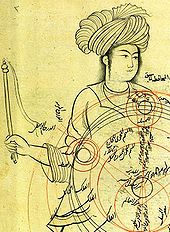
Religious views
Many Islamic scholars declared a mutual agreement (Ijma) that celestial bodies are round, among them Ibn Hazm (d. 1069), Ibn al-Jawzi (d. 1200), and Ibn Taymiya (d. 1328).[87] Ibn Taymiya said, "Celestial bodies are round—as it is the statement of astronomers and mathematicians—it is likewise the statement of the scholars of Islam". Qutb al-Din al-Shirazi (d.1311) drew a planetary model which depicted the celestial bodies in an epicyclic model. Abul-Hasan ibn al-Manaadi, Abu Muhammad Ibn Hazm, and Abul-Faraj Ibn Al-Jawzi have said that the Muslim scholars are in agreement that all celestial bodies are round. Ibn Taymiyah also remarked that Allah has said, "And He (Allah) it is Who created the night and the day, the sun and the moon. They float, each in a Falak." Ibn Abbas says, "A Falaka like that of a spinning wheel." The word 'Falak' (in the Arabic language) means "that which is round."[87][88]
The Muslim scholars who held to the round earth theory used it in an impeccably Islamic manner, to calculate the distance and direction from any given point on the earth to Makkah (Mecca). This determined the Qibla, or Muslim direction of prayer. Muslim mathematicians developed spherical trigonometry which was used in these calculations.[89] Ibn Khaldun (d. 1406), in his Muqaddimah, also identified the world as spherical. The belief of some later Muslim scholars, like Suyuti (d. 1505), that the earth is flat represents a deviation from this earlier opinion.[87]
Modern belief in Flat Earth
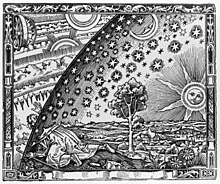
It is a modern misconception that the prevailing cosmological view during the Middle Ages saw the Earth as flat, instead of spherical. During the early Middle Ages, many scholars maintained the spherical viewpoint first expressed by the Ancient Greeks. By the 14th century, belief in a flat earth among the educated was essentially dead[citation needed]. Flat-Earth models were in fact discarded well before medieval times, when the spherical model became commonly accepted in Hellenistic astronomy by Classical Greece.[90].
During the 19th century, the Romantic conception of a European "Dark Age" gave much more prominence to the Flat Earth model than it ever possessed historically.
In 1945 the Historical Association listed "Columbus and the Flat Earth Conception" second of twenty in its first-published pamphlet on common errors in history.[91]
Flat Earth Society

The last known group of Flat Earth proponents, the Flat Earth Society, kept the concept alive and at one time claimed a few thousand followers. The last president of the Society, Charles K. Johnson, spent years examining the studies of flat and round earth theories and proposed evidence of a conspiracy against flat-earth: "The idea of a spinning globe is only a conspiracy of error that Moses, Columbus, and FDR all fought…" His article was published in the magazine Science Digest, 1980. It goes on to state,
"If it is a sphere, the surface of a large body of water must be curved. The Johnsons have checked the surfaces of Lake Tahoe and the Salton Sea (a shallow salt lake in southern California near the Mexican border) without detecting any curvature."[92]
The Society declined in the 1990s following a fire at its headquarters in California and the death of Charles K. Johnson in 2001.[93]
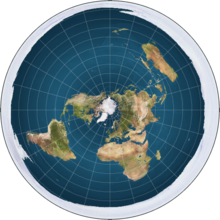
Other modern flat-earthers
William Carpenter (1830–1896) published "A hundred proofs the Earth is not a Globe".[96] For example, he argues that
"there are rivers that flow for hundreds of miles towards the level of the sea without falling more than a few feet — notably, the Nile, which, in a thousand miles, falls but a foot. A level expanse of this extent is quite incompatible with the idea of the Earth's 'convexity'"; and that an aeronaut at the highest possible altitude will see what appears to be a concave surface "this being exactly what is to be expected of a surface that is truly level, since it is the nature of level surfaces to appear to rise to a level with the eye of the observer".
English writer Samuel Rowbotham (1816–1885), writing under the pseudonym "Parallax," published results of many experiments which tested the curvatures of water over lakes. He also produced studies which purported to show the effects of ships disappearing below the horizon can be explained by the laws of perspective in relation to the human eye.[97]
Transvaal perspective
In 1898 during his solo circumnavigation of the world Joshua Slocum encountered such a group in Durban. Three Boers, one of them a clergyman, presented Slocum with a pamphlet in which they set out to prove that the world was flat. President Kruger of the Transvaal Republic advanced the same view: "You don't mean round the world, it is impossible! You mean in the world. Impossible!"[98]
Cultural references
The notion of a flat Earth continues to be referred to in a wide range of contexts. Indirect references to the theory include the widely used idiom "the four corners of the earth".
An early mention in literature was Ludvig Holberg's comedy Erasmus Montanus (1723). Erasmus Montanus meets considerable opposition when he claims the Earth is round, since all the peasants hold it to be flat. He is not allowed to marry his fiancée until he cries "The earth is flat as a pancake". In Rudyard Kipling's The Village that Voted the Earth was Flat, the protagonists spread the rumor that a Parish Council meeting had voted in favor of a flat Earth. The 1980 film The Gods Must Be Crazy concerns a Bushman of the Kalahari who decides to travel to "the edge of the world" to dispose of a Coca-Cola bottle that he thinks has evil powers.
Fantasy fiction is particularly rich in references to flat worlds. In C. S. Lewis' The Voyage of the Dawn Treader the fictional world of Narnia is "round like a table" (i.e., flat), not "round like a ball", and the characters sail toward the edge of this world (although, in Lewis' subsequent Narnian novel The Silver Chair, the Earth itself is accepted and written as being spherical, with Narnian king Caspian X being amazed by this fact). Terry Pratchett's Discworld novels (1983 onwards) are set on a flat, disc-shaped world resting on the backs of four huge elephants which are in turn standing on the back of an enormous turtle. Many explorers died falling off the edge trying to prove that it's not so.
The term 'flat earthers' is a recognizable slang, referent to persons or organizations who cling to antiquarian beliefs which have long since been disproven.
See also
- Spherical Earth
- Bedford Level experiment
- Geographical distance
- Hollow earth
- Scientific mythology
- Skepticism
Further reading
- Fraser, Raymond (2007). When The Earth Was Flat: Remembering Leonard Cohen, Alden Nowlan, the Flat Earth Society, the King James monarchy hoax, the Montreal Story Tellers and other curious matters. Black Moss Press, ISBN 978-0-88753-439-3
- Garwood, Christine (2007) Flat Earth: The History of an Infamous Idea, Pan Books, ISBN 140504702X
- Simek, Rudolf (trans.Angela Hall) "Heaven and Earth in the Middle Ages"[18]
Notes
- ^ When Aquinas wrote his Summa, at the very beginning (Summa Theologica Ia, q. 1, a. 1; see also Summa Theologica IIa Iae, q. 54, a. 2), the idea of a round earth was the example used when he wanted to show that fields of science are distinguished by their methods rather than their subject matter... "Sciences are distinguished by the different methods they use. For the astronomer and the physicist both may prove the same conclusion - that the earth, for instance, is round: the astronomer proves it by means of mathematics, but the physicist proves it by the nature of matter. History of Science: Shape of the Earth: Middle Ages: Aquinas"
References
- ^ Continuation of Greek concept into Roman and medieval Christian thought: Reinhard Krüger: Materialien und Dokumente zur mittelalterlichen Erdkugeltheorie von der Spätantike bis zur Kolumbusfahrt (1492)
- ^ Direct adoption of the Greek concept by Islam: Ragep, F. Jamil: "Astronomy", in: Krämer, Gudrun (ed.) et al.: Encyclopaedia of Islam, THREE, Brill 2010, without page numbers
- ^ Direct adoption by India: D. Pingree: "History of Mathematical Astronomy in India", Dictionary of Scientific Biography, Vol. 15 (1978), pp. 533−633 (554f.); Glick, Thomas F., Livesey, Steven John, Wallis, Faith (eds.): "Medieval Science, Technology, and Medicine: An Encyclopedia", Routledge, New York 2005, ISBN0-415-96930-1, p. 463
- ^ Adoption by China via European science: Jean-Claude Martzloff, “Space and Time in Chinese Texts of Astronomy and of Mathematical Astronomy in the Seventeenth and Eighteenth Centuries”, Chinese Science 11 (1993-94): 66-92 (69) and Christopher Cullen, "A Chinese Eratosthenes of the Flat Earth: A Study of a Fragment of Cosmology in Huai Nan tzu 淮 南 子", Bulletin of the School of Oriental and African Studies, Vol. 39, No. 1 (1976), pp. 106-127 (107)
- ^ a b c Russell, Jeffrey B. "The Myth of the Flat Earth". American Scientific Affiliation. Retrieved 2007-03-14.
- ^ Members of the Historical Association (1945). Common errors in history. General Series, G.1. London: P.S. King & Staples for the Historical Association., pp.4–5. The Historical Association published a second list of 17 other common errors in 1947.
- ^ H. and H. A. Frankfort, J. A. Wilson, and T. Jacobsen, Before Philosophy (Baltimore: Penguin, 1949) 54.
- ^ Seeley The Geographical Meaning of "Ëarth" and "Seas" in Genesis 1:10, Westminster Theological Journal 59 (1997), p.246
- ^ Paul H. Seely, The Firmament and the Water Above, Westminster Theological Journal 53 (1991)
- ^ Henry M. Morris, Science and the Bible Chicago: Moody Press, 1986 ISBN 0802406564 . pp. 13-14. Jason Lisle, Taking Back Astronomy: The Heavens Declare Creation, Green Forest, AR: Master Books, !SBN 978089051479, adapted online at Answers in Genesis. See also the 16th century Douay-Rheims Version of this text, where the critical word is translated as "globe"
- ^ Leslie C. Allen, entry #2552 ḥwg volume 2, page 40 in New International Dictionary of Old Testament Theology and Exegesis, general editor Willem A. VanGemeren, Grand Rapids, Michigan: Zondervan, ISBN 0-310-20217-5. Jan L. Koole Historical Commentary on the Old Testament: Isaiah: Part 3, translated by Anthony P. Runia. Kampen, The Netherlands: Kok Pharos Publishing House, 1997 ISBN 90-390-0173-1, volume 1 page 108. K. Seybold, entry on chûgh, volume 4, pages 244-247, Theological Dictionary of the Old Testament, edited by G. Johannes Botterweck, Helmer Ringgren, translated by David E. Green (from Theologisches Wörterbuch zum Alten Testament, Verlag W. Kohlhammer, 1976, Band 2 p. 780), Grand Rapids, Michigan: Eerdmans, 1980 ISBN 0-8028-2338-6.
- ^ A Concordance of the Hebrew and Chaldee Scriptures, by B. Davidson. See also Wilson's Old Testament Word Studies, by William Wilson.
- ^ See the discussion and references given in Book of Isaiah#Dating of Isaiah
- ^ "... his cosmology consisted of a spherical earth and a finite, motionless, spherical universe." Parmenides of Elia (ca. 515-after 450 BC) - Eric W. Weisstein's World of Scientific Biography
- ^ Burch, George Bosworth (1954). "The Counter-Earth". Osirus. 11. Saint Catherines Press: 267–294. doi:10.1086/368583.
- ^ De Fontaine, Didier (2002). "Flat worlds: Today and in antiquity". Memorie della Società Astronomica Italiana, special issue. 1 (3): 257–62. Retrieved 2007-08-03.
- ^ Anaximander; Fairbanks (editor and translator), Arthur. "Fragments and Commentary". The Hanover Historical Texts Project.
{{cite journal}}:|last=has generic name (help) (Plut., Strom. 2 ; Dox. 579). - ^ Hugh Thurston, Early Astronomy, (New York: Springer-Verlag), p. 118. ISBN 0-387-94107-X.
- ^ Lloyd, G.E.R. (1968). Aristotle: The Growth and Structure of His Thought. Cambridge Univ. Press. pp. 162–164.
- ^ Aristotle, De caelo, 297b24-31
- ^ Aristotle, De caelo, 297b31-298a10
- ^ Strabo (1960) [1917]. The Geography of Strabo, in Eight Volumes. Loeb Classical Library edition, translated by Horace Leonard Jones, A.M., Ph.D. London: William Heinemann., Vol.I Bk. I para. 20, pp.41, 43. An earlier edition is available online.
- ^ Odyssey, Bk. 5 393: "As he rose on the swell he looked eagerly ahead, and could see land quite near." Samuel Butler's translation is available online.
- ^ Van Helden, Albert (1985). Measuring the Universe: Cosmic Dimensions from Aristarchus to Halley. University of Chicago Press. pp. 4–5. ISBN 0-226-84882-5.
- ^ a b Natural History, 2.64
- ^ Ptolemy. Almagest. pp. I.4. as quoted in Grant, Edward (1974). A Source Book in Medieval Science. Harvard University Press. pp. 63–4.
- ^ a b Macrobius. Commentary on the Dream of Scipio, V.9-VI.7, XX. pp. 18–24., translated in Stahl, W. H. (1952). Martianus Capella, The Marriage of Philology and Mercury. Columbia University Press.
- ^ As depicted by the (spherical) globus cruciger, on coins by Theodosius II
- ^ De Civitate Dei, Book XVI, Chapter 9 — Whether We are to Believe in the Antipodes, translated by Rev. Marcus Dods, D.D.; from the Christian Classics Ethereal Library at Calvin College
- ^ q:Augustine of Hippo
- ^ Leo Ferrari, Cosmography, in Augustine through the Ages: An Encyclopedia, William B. Eerdmans Publishing Co., Grand Rapids MI, 1999, p.246
- ^ Leo Ferrari, Augustine's Cosmography, Augustinian Studies, 27:2 (1996), 129-177.
- ^ Lactantius, The Divine Institutes, Book III [1], Chapter XXIV, THE ANTE-NICENE FATHERS, Vol VII, ed. Rev. Alexander Roberts, D.D., and James Donaldson, LL.D., American reprint of the Edinburgh edition (1979), W.B.Eerdmans Publishing Co.,Grand Rapids, MI, pp.94-95.
- ^ J. L. E. Dreyer, A History of Planetary Systems from Thales to Kepler. (1906); unabridged republication as A History of Astronomy from Thales to Kepler (New York: Dover Publications, 1953).
- ^ J.L.E. Dreyer, A History of Planetary Systems', (1906), p.211-12.
- ^ St. John Chrysostom, Homilies Concerning the Statutes, Homily IX [2], paras.7-8, in A SELECT LIBRARY OF THE NICENE AND POST-NICENE FATHERS OF THE CHRISTIAN CHURCH, Series I, Vol IX, ed. Philip Schaff, D.D.,LL.D., American reprint of the Edinburgh edition (1978), W.B.Eerdmans Publishing Co.,Grand Rapids, MI, pp.403-404.
- ^ St.Athanasius, Against the Heathen, Ch.27 [3], Ch 36 [4], in A SELECT LIBRARY OF THE NICENE AND POST-NICENE FATHERS OF THE CHRISTIAN CHURCH, Series II, Vol IV, ed. Philip Schaff, D.D.,LL.D., American reprint of the Edinburgh edition (1978), W.B.Eerdmans Publishing Co.,Grand Rapids, MI.
- ^ See Leone Montagnini, La questione della forma della Terra. Dalle origini alla tarda Antichità, in Studi sull'Oriente Cristiano, 13/II: 31-68
- ^ Saint Basil the Great, Hexaemeron 9 - HOMILY IX - "The creation of terrestrial animals" Holy Inocents Orthodox Church.[5]
- ^ B. Eastwood and G. Graßhoff, Planetary Diagrams for Roman Astronomy in Medieval Europe, ca. 800-1500, Transactions of the American Philosophical Society, 94, 3 (Philadelphia, 2004), pp. 49-50.
- ^ Bruce S. Eastwood, Ordering the Heavens: Roman Astronomy and Cosmology in the Carolingian Renaissance, (Leiden: Brill, 2007), pp. 62-3.
- ^ S. C. McCluskey, Astronomies and Cultures in Early Medieval Europe, (Cambridge: Cambridge Univ. Pr., 1998), pp. 114, 123.
- ^ Isidore, Etymologiae, XIV.ii.1 [6]; Wesley M. Stevens, "The Figure of the Earth in Isidore's De natura rerum", Isis, 71(1980): 268-277.
- ^ Isidore, Etymologiae, XIV.v.17 [7].
- ^ Isidore, Etymologiae, IX.ii.133 [8].
- ^ Faith Wallis, trans., Bede: The Reckoning of Time, (Liverpool: Liverpool Univ. Pr., 2004), pp. lxxxv-lxxxix.
- ^ Ælfric of Eynsham, On the Seasons of the Year, Peter Baker, trans
- ^ MGH, Epistolae Selectae 1, 80, pp. 178-9.[9]; translation in M. L. W. Laistner, Thought and Letters in Western Europe: A.D. 500 to 900, 2nd. ed., (Ithaca: Cornell Univ. Pr., 1955), pp. 184-5.
- ^ Catholic Encyclopedia
- ^ Klaus Anselm Vogel, "Sphaera terrae - das mittelalterliche Bild der Erde und die kosmographische Revolution," PhD dissertation Georg-August-Universität Göttingen, 1995, p. 19.[10]
- ^ E. Grant, Planets. Stars, & Orbs: The Medieval Cosmos, 1200-1687, (Cambridge: Cambridge Univ. Pr., 1994), pp. 626-630.
- ^ "Summa Theologica IIa Iae, q. 54, a. 2".
- ^ Reinhard Krüger, Materialien und Dokumente zur mittelalterlichen Erdkugeltheorie von der Spätantike bis zur Kolumbusfahrt (1492) [11]
- ^ James. W. Loewen, Lies My Teacher Told Me: Everything Your History Textbook Got Wrong, (Touchstone Books, 1996), p. 56
- ^ Washington Irving, The Life and Voyages of Christopher Columbus, revised ed. (New York, 1861), vol. 1, pp. 89-90.
- ^ Irving, p. 91.
- ^ Ptolemy, Geography, book 1:14.
- ^ Samuel Eliot Morison, Admiral of the Ocean Sea. A Life of Christopher Columbus (Boston: Little Brown, 1942), vol. 1, p. 65. George E. Nunn, The Geographical Conceptions of Columbus (1924), expanded edition (Milwaukee: American Geographical Society/University of Milwaukee, 1992), pp. 27-30.
- ^ Nunn, pp. 1-2, 27-30.
- ^ Morison, pp. 209, 211.
- ^ a b c d e f D. Pingree: "History of Mathematical Astronomy in India", Dictionary of Scientific Biography, Vol. 15 (1978), pp. 533−633 (554f.)
- ^ Sarma, K.V. (2008), "Astronomy in India", Encyclopaedia of the History of Science, Technology, and Medicine in Non-Western Cultures (2nd edition) edited by Helaine Selin, pp. 317, Springer, ISBN 9781402045592
- ^ Glick, Thomas F., Livesey, Steven John, Wallis, Faith (eds.): "Medieval Science, Technology, and Medicine: An Encyclopedia", Routledge, New York 2005, ISBN0-415-96930-1, p. 463
- ^ "Aryabhata I biography". History.mcs.st-andrews.ac.uk. November 2000. Retrieved 2008-11-16.
- ^ Gongol, William J. (December 14, 2003). "The Aryabhatiya: Foundations of Indian Mathematics". GONGOL.com. Retrieved 2008-11-16.
- ^ a b Needham, Joseph (1986). Science and Civilization in China: Volume 3. Taipei: Caves Books, Ltd. pp. 498.
- ^ a b "Jean-Claude Martzloff, "Space and Time in Chinese Texts of Astronomy and of Mathematical Astronomy in the Seventeenth and Eighteenth Centuries", Chinese Science 11 (1993-94): 66-92 (69)" (PDF). Cite error: The named reference "Jean-Claude Martzloff 69" was defined multiple times with different content (see the help page).
- ^ Christopher Cullen, “Joseph Needham on Chinese Astronomy”, Past and Present, No. 87. (May, 1980), pp. 39-53 (42 & 49)
- ^ Christopher Cullen, "A Chinese Eratosthenes of the Flat Earth: A Study of a Fragment of Cosmology in Huai Nan tzu 淮 南 子", Bulletin of the School of Oriental and African Studies, Vol. 39, No. 1 (1976), pp. 106-127 (107-109)
- ^ Christopher Cullen, "A Chinese Eratosthenes of the Flat Earth: A Study of a Fragment of Cosmology in Huai Nan tzu 淮 南 子", Bulletin of the School of Oriental and African Studies, Vol. 39, No. 1 (1976), pp. 106-127 (107)
- ^ Christopher Cullen, "A Chinese Eratosthenes of the Flat Earth: A Study of a Fragment of Cosmology in Huai Nan tzu 淮 南 子", Bulletin of the School of Oriental and African Studies, Vol. 39, No. 1 (1976), pp. 106-127 (108)
- ^ Christopher Cullen, “Joseph Needham on Chinese Astronomy”, Past and Present, No. 87. (May, 1980), pp. 39-53 (42)
- ^ a b c Christopher Cullen, "A Chinese Eratosthenes of the Flat Earth: A Study of a Fragment of Cosmology in Huai Nan tzu 淮 南 子", Bulletin of the School of Oriental and African Studies, Vol. 39, No. 1 (1976), pp. 106-127 (109)
- ^ A spherical terrestrial globe was introduced to Beijing in 1267 by the Persian astronomer Jamal ad-Din, but it is not known to have made an impact on the traditional Chinese conception of the shape of the Earth (cf. Joseph Needham et al.: "Heavenly clockwork: the great astronomical clocks of medieval China", Antiquarian Horological Society, 2nd. ed., Vol. 1, 1986, ISBN 0-521-32276-6, p. 138)
- ^ a b c Needham, Joseph (1986). Science and Civilization in China: Volume 3. Taipei: Caves Books, Ltd. pp. 499.
- ^ a b c Ragep, F. Jamil: "Astronomy", in: Krämer, Gudrun (ed.) et al.: Encyclopaedia of Islam, THREE, Brill 2010, without page numbers
- ^ Gharā'ib al-funūn wa-mulah al-`uyūn (The Book of Curiosities of the Sciences and Marvels for the Eyes), 2.1 "On the mensuration of the Earth and its division into seven climes, as related by Ptolemy and others", (ff. 22b-23a)
- ^ John Brian Harley and David Woodward (ed.), The History of cartography, Volume 2, Book 1: Cartography in the Traditional Islamic and South Asian Societies (Chicago: University of Chicago Press, 1992), p.177, ISBN 0-226-31635-1. The medieval arabic mile was 1.972 km.
- ^ Edward S. Kennedy, Mathematical Geography, pp=187–8, in (Rashed & Morelon 1996, pp. 185–201)
- ^ Khwarizm, Foundation for Science Technology and Civilisation.
- ^ James S. Aber (2003). Al-biruni calculated the Earth's circumference at a small town of Pind Dadan Khan, District Jhelum, Punjab, Pakistan.Abu Rayhan al-Biruni, Emporia State University.
- ^ Lenn Evan Goodman (1992), Avicenna, p. 31, Routledge, ISBN 041501929X.
- ^ a b Behnaz Savizi (2007), "Applicable Problems in History of Mathematics: Practical Examples for the Classroom", Teaching Mathematics And Its Applications, 26 (1), Oxford University Press: 45–50, doi:10.1093/teamat/hrl009 (cf. Behnaz Savizi. "Applicable Problems in History of Mathematics; Practical Examples for the Classroom". University of Exeter. Retrieved 2010-02-21.)
- ^ a b c Beatrice Lumpkin (1997), Geometry Activities from Many Cultures, Walch Publishing, pp. 60 & 112–3, ISBN 0825132851 [12]
- ^ Jim Al-Khalili, The Empire of Reason 2/6 (Science and Islam - Episode 2 of 3) on YouTube, BBC
- ^ O'Connor, John J.; Robertson, Edmund F., "Al-Biruni", MacTutor History of Mathematics Archive, University of St Andrews
- ^ a b c History, Science and Civilization: Early Muslim Consensus: The Earth is Round.
- ^ "Majmu'ul-Fatawa, Vol. 6, pp. 566". Archived from the original on 2007-03-12. (In Arabic.)
- ^ David A. King, Astronomy in the Service of Islam, (Aldershot (U.K.): Variorum), 1993.
- ^ Catholic Encyclopaedia: "On this point as on many others, the Bible simply reflects the current cosmological ideas and language of the time" etc.
- ^ Members of the Historical Association (1945). Common errors in history. General Series, G.1. London: P.S. King & Staples for the Historical Association., pp.4–5. The Historical Association published a second list of 17 other common errors in 1947.
- ^ "The Flat-out Truth". Retrieved 2007-09-15.
- ^ Donad E. Simanek, The Flat Earth.
- ^ Schadewald, Robert J "The Flat-out Truth:Earth Orbits? Moon Landings? A Fraud! Says This Prophet" Science Digest July 1980
- ^ Schick, Theodore; Lewis Vaughn How to think about weird things: critical thinking for a new age Houghton Mifflin (Mayfield) (31 Oct 1995) ISBN 978-1559342544 p.197
- ^ William Carpenter, One hundred proofs that the earth is not a globe, (Baltimore: The author, 1885).[13]
- ^ Parallax (Samuel Birley Rowbotham), Zetetic Astronomy: Earth Not a Globe, Third edition, (London:Simpkin, Marshall, and Co.,1881).[14]
- ^ Joshua Slocum, Sailing Alone Around the World, (New York: The Century Company, 1900), chaps. 17-18.[15]
External links
- The Myth of the Flat Earth
- The Myth of the Flat Universe
- 7000 Years of Thinking Regarding Earth's Shape
- You say the earth is round? Prove it (from The Straight Dope)
- Flat Earth Fallacy
- Zetetic Astronomy, or Earth Not a Globe by Parallax (Samuel Birley Rowbotham (1816-1884)) at sacred-texts.com
- The flat-earth myth and creationism
